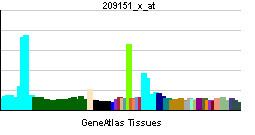Entrez 6929 | Ensembl ENSG00000071564 | |
 | ||
Aliases TCF3, E2A, E47, ITF1, TCF-3, VDIR, bHLHb21, AGM8, transcription factor 3 External IDs MGI: 98510 HomoloGene: 2408 GeneCards: TCF3 | ||
Transcription factor 3 (E2A immunoglobulin enhancer-binding factors E12/E47), also known as TCF3, is a protein that in humans is encoded by the TCF3 gene. TCF3 has been shown to directly enhance Hes1 (a well-known target of Notch signaling) expression.
Contents
Function
This gene encodes a member of the E protein (class I) family of helix-loop-helix transcription factors. The 9aaTAD transactivation domains of E proteins and MLL are very similar and both bind to the KIX domain of general transcriptional mediator CBP. E proteins activate transcription by binding to regulatory E-box sequences on target genes as heterodimers or homodimers, and are inhibited by heterodimerization with inhibitor of DNA-binding (class IV) helix-loop-helix proteins. E proteins play a critical role in lymphopoiesis, and the encoded protein is required for B and T lymphocyte development.
This gene regulates many developmental patterning processes such as lymphocyte and central nervous system (CNS) development. E proteins are involved in the development of lymphocytes. They initiate transcription by binding to regulatory E-box sequences on target genes. Additionally, development of the neocortex of the brain is controlled in part by a Wnt signaling pathway. This pathway is essential for proper neuronal differentiation and proliferation of neural precursor cells. However, Wnt must be suppressed until it is the appropriate time in development to initiate neuronal differentiation and proliferation of neural precursor cells. The TCF3 gene has been shown to play a role in suppressing Wnt for this purpose. Furthermore, TCF3 has been shown to represses β-catenin in this pathway as well. Undifferentiated neural precursor cells contain high expression of TCF3, but as those cells become more differentiated, the expression of TCF3 decreases. Therefore, lack of TCF3 increases neural precursor cell reprogramming and greater expression of TCF3 suppresses reprogramming of neural precursor cells. In a TCF3 knock out model in mice, the mesoderm forms, but the structures of the mesoderm, specifically structures of the CNS, are duplicated. Therefore, repressive functions of TCF3 are necessary for proper anterior-posterior axis development.
Clinical significance
Deletion of this gene or diminished activity of the encoded protein may play a role in lymphoid malignancies. This gene is also involved in several chromosomal translocations that are associated with lymphoid malignancies including pre-B-cell acute lymphoblastic leukemia (t(1;19), with PBX1 and t(17;19), with HLF), childhood leukemia (t(19;19), with TFPT) and acute leukemia (t(12;19), with ZNF384).
Interactions
TCF3 has been shown to interact with:
